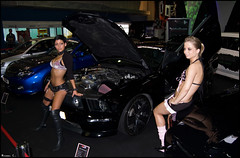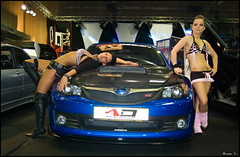Ford is unveiling the dramatic new Ford B-MAX at the 2011 Geneva Motor Show, providing an early preview of exciting innovations from Ford in the European small car market.
The Ford B-MAX showcases a unique new body design which eliminates the traditional B pillar and features twin rear sliding doors. This innovative format - which has already been engineered for production - promises best-in-class access to the cabin, together with unmatched convenience and flexibility.
Developing themes from the 2009 iosis MAX design study, the dynamic and stylish new B-MAX illustrates how Ford's kinetic design language can be translated to a unique new vehicle format.
The innovation continues inside the cabin, where the interior offers exceptional space and versatility for such a compact vehicle. The use of high quality materials highlights the vision that small, practical cars can also be comfortable and well-equipped.
"With its highly popular S-MAX and Galaxy, and more recently the all-new C-MAX and Grand C-MAX, Ford has a proven history of bringing innovation and style to the multi-activity vehicle market," said Stephen Odell, Chairman and CEO, Ford of Europe."The new Ford B-MAX signals that Ford is ready to bring the same bold thinking to the small car market. With its unique door format and dynamic design, the B-MAX sends a strong message that customers looking for a compact, stylish and versatile vehicle will soon have an exciting new choice." he added.
New vision for compact vehicles
The Ford B-MAX previews some of the exciting innovations developed by Ford for the European small car market. Based on Ford's global B-car platform - shared with the highly successful new Fiesta - the B-MAX on show at Geneva outlines the company's vision for a compact vehicle which combines outstanding space and versatility with stylish design.
At slightly more than 4 metres in length, the Ford B-MAX is just 11 cm longer than the Fiesta five-door, and is a full 32 cm shorter than the new C-MAX.
With this highly compact footprint, the Ford B-MAX is ideally placed to meet the fast-growing demand for downsized cars which are better suited to congested urban conditions, but without sacrificing interior space and comfort.
"With the Ford B-MAX we set out to create a vehicle that captures the spirit of a smaller S-MAX," said Martin Smith, Ford of Europe's Executive Design Director. "We wanted to show that a small car could be very spacious and practical inside, while still having the sleek, dynamic appearance that has made the S-MAX so popular."
Unique integrated B-pillar doors
The key innovation on the Ford B-MAX is the adoption of a unique integrated B-pillar door concept, which promises new levels of convenience and flexibility for small cars.
This new body design eliminates the traditional B-pillar structure at the trailing edge of the front door, which connects the roof to the floor. Instead, the body side features an integrated B-pillar, and access to the interior is via a conventional front door or a rear sliding door, each of which can open independently.
This innovative format - which has already been engineered for production - offers best-in-class access to the cabin via the huge uninterrupted aperture, together with unmatched convenience and flexibility.
"Our iosis MAX design study demonstrated the advantages that an integrated B-pillar door format can offer the MAV-style vehicle," said Martin Smith. "The B-MAX takes this idea to the next level, with a production-ready solution that is neatly integrated into the overall vehicle design."
Unmatched interior versatility
The Ford B-MAX combines the integrated B-pillar door format with a flexible and easy-to-use seating system, resulting in an interior which offers unmatched practicality and versatility.
With both front and rear doors open there is outstanding access to the interior, with a huge, clear aperture measuring over 1.5 metres wide. This is around twice the width offered by competitors with alternative door concepts, making it significantly easier to enter or exit the rear seats, attend to children in child seats, or load shopping.
Having folded the 60/40 split rear seats and the front passenger seat to create an extensive flat load floor, the side access is particularly convenient to load bulky items such as flat-pack furniture or even a bicycle.
With the front passenger seat folded, the interior is capable of swallowing exceptionally long loads measuring up to 2.35 metres in length.
Sitting 11cm taller than Fiesta, the B-MAX also provides extremely generous accommodation for its occupants. Drivers benefit from a higher 'command' seating position, while rear seat legroom and headroom is significantly improved.
Engineered for outstanding safety
In developing the Ford B-MAX's unique integrated B-pillar body design for production, Ford engineers have ensured that it delivers the same outstanding levels of crash protection as Ford products with a more conventional structure.
To deliver the required performance in side impacts, the structure of both front and rear doors has been significantly strengthened - with ultra-high-strength Boron steel in key load-bearing areas - so that the door frames work together to absorb energy like a 'virtual B pillar'.
Special safety interlocks and reinforced latch mechanisms ensure that the doors remain firmly fixed to the roof and floor structure during an impact, and enable the front and rear doors to act together to protect the occupants.
When these measures are combined with other structural enhancements to the bodyshell and the latest restraint system technologies, the result is a body design which meets the highest safety standards.
"Many concept cars have featured integrated B-pillar body designs before, but this time it's for real!" explained Martin Smith. "The Ford B-MAX shows how this new format can deliver unmatched practicality, but still achieve outstanding safety as well."
Compact, sporty and stylish
The exterior design of the B-MAX shows how Ford's kinetic design language can be applied to its unique new vehicle format, creating a compact, sporty and stylish car which adds its own distinctive character to Ford's popular MAV line-up.
"In developing the B-MAX, our designers took inspiration from the earlier iosis MAX design study, which established an exciting new vision for our compact MAVs," said Martin Smith. "While it shares kinetic design themes with other recent Ford models, the unique door concept and compact size gives the B-MAX its own distinct identity."
The vehicle's striking front-end features a bold new interpretation of Ford's signature trapezoidal grille, with five strong horizontal grille elements picked out in a bright chrome finish.
Beneath this a slimmer lower grille, finished in gloss black, adds visual stability to the front-end, and emphasises the car's sporty wide stance.
Other distinctive kinetic design elements include strong headlamp graphics, the muscular shoulder line with its powerful undercut, a characteristic window line with its kick-up behind the rear doors, and the prominent wheel lips.
The bold three-dimensional surfacing of the body sides helps to avoid the tall, blocky look which is common in this class of vehicle, and includes a unique new rocker treatment, with a stylish 'zig-zag' form on the rear doors.
With its distinctive window graphic, wraparound tailgate glass, and slim tail lamps split by the tailgate, the rear of the Ford B-MAX is closely reminiscent of the S-MAX. Strong horizontal feature lines help to emphasis the vehicle's wide and confident stance.
The B-MAX is finished in Burnished Glow, a warm and contemporary metallic brown shade. The paintwork is complemented by striking 18-inch 5-spoke alloy wheels, which have a Y-shaped spoke pattern derived from a signature S-MAX wheel design.
Spacious premium interior
The interior of the Ford B-MAX offers exceptional space and versatility for such a compact vehicle. The cabin is immaculately trimmed in contemporary, high quality materials, highlighting that small, practical cars can also be comfortable and well-equipped.
With its bold graphics and sculptured surfaces, the interior develops the kinetic design themes from Ford's latest small and medium cars. Distinctive features include the slim, wing-like section of the upper instrument panel (IP) which reaches out to the door panels, and the prominent centre console, which flows down between the front seats from the IP.
The cabin retains the dynamic, sporty feel of Ford's small-car interiors, but introduces the more premium character and decorative elements from the larger C-MAX.
Driver controls are based on Ford's latest HMI (Human Machine Interface) approach, with a large 6-inch touch screen display mounted in the centre of the upper IP, above the much-acclaimed mobile-phone style integrated control panel.
To reflect the more sophisticated tastes of buyers who are downsizing to compact vehicles, the B-MAX interior is finished in the highest quality materials, with a stylish and contemporary brown colour theme.
The upper IP and doors are wrapped in ebony black premium full grain leather, with contrasting bronze brown stitching. The front seats feature leather bolsters, combined with central panels trimmed with a technical black/brown high-performance fabric.
Further details, which add to the elegant and sporty feel, include a deep brown metallic finish to the centre console bezels, and textured black flooring produced from woven leather with bronze brown highlights.
The sensation of space in the interior is enhanced by a full-size panoramic glass roof, which covers the entire roof area.
Ultra-low CO2 powertrain
The Ford B-MAX is powered by an ultra-low-CO2 powertrain, featuring a state-of-the-art three-cylinder 1.0-litre Ford EcoBoost petrol engine equipped with the Ford Auto-Start-Stop system.
This three-cylinder Ford EcoBoost engine was first previewed in the Start concept vehicle displayed at the Beijing Motor Show in 2010, and represents the next addition to the global family of Ford EcoBoost engines.
Like the 1.6- and 2.0-litre four-cylinder Ford EcoBoost engines, which have recently been launched in Ford's European medium and large cars, the 1.0-litre unit combines direct fuel injection, turbocharging and twin independent variable cam timing to achieve significant reductions in fuel-consumption and CO2 emissions.
Designed to replace larger conventional four-cylinder petrol engines, the three-cylinder Ford EcoBoost engine is undergoing final development prior to its production launch.
"The B-MAX demonstrates Ford's commitment to providing customers with exciting and innovative vehicles," said Stephen Odell. "We believe that the new concepts and technologies it showcases will have a major impact on the small car market.
























